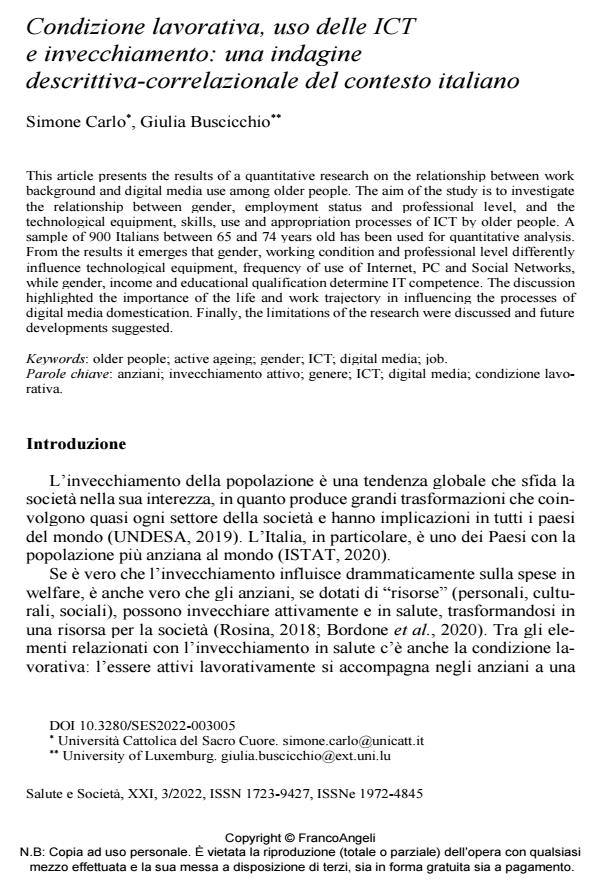Condizione lavorativa, uso delle ICT e invecchiamento: una indagine descrittiva-correlazionale del contesto italiano
Journal title SALUTE E SOCIETÀ
Author/s Simone Carlo, Giulia Buscicchio
Publishing Year 2022 Issue 2022/3
Language Italian Pages 16 P. 64-79 File size 430 KB
DOI 10.3280/SES2022-003005
DOI is like a bar code for intellectual property: to have more infomation
click here
Below, you can see the article first page
If you want to buy this article in PDF format, you can do it, following the instructions to buy download credits

FrancoAngeli is member of Publishers International Linking Association, Inc (PILA), a not-for-profit association which run the CrossRef service enabling links to and from online scholarly content.
This article presents the results of a quantitative research on the relationship between work background and digital media use among older people. The aim of the study is to investigate the relationship between gender, employment status and professional level, and the technological equipment, skills, use and appropriation processes of ICT by older people. A sample of 900 Italians between 65 and 74 years old has been used for quantitative analysis. From the results it emerges that gender, working condition and professional level differently influence technological equipment, frequency of use of Internet, PC and Social Networks, while gender, income and educational qualification determine IT competence. The discussion highlighted the importance of the life and work trajectory in influencing the processes digital media domestication. Finally, the limitations of the research were discussed and future developments suggested.
Keywords: older people; active ageing; gender; ICT; digital media; job.
- Digital Media Domestication and Job Paths Among Older People: An Ethnographic Investigation Simone Carlo, Giulia Buschicchio, in Media and Communication /2023
DOI: 10.17645/mac.v11i3.6710 - Le ICT nei contesti di fragilità e ageing: la sfida relazionale Fausto Pagnotta, in WELFARE E ERGONOMIA 1/2023 pp.199
DOI: 10.3280/WE2023-001017 - Human Aspects of IT for the Aged Population Fausto Colombo, Piermarco Aroldi, Simone Carlo, pp.457 (ISBN:978-3-031-34916-4)
Simone Carlo, Giulia Buscicchio, Condizione lavorativa, uso delle ICT e invecchiamento: una indagine descrittiva-correlazionale del contesto italiano in "SALUTE E SOCIETÀ" 3/2022, pp 64-79, DOI: 10.3280/SES2022-003005